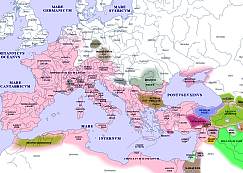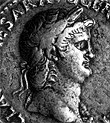Roman Emperors Dir Nero

Nero (54-68 A.D.)
David J. Coffta
Canisius CollegeThe death of Claudius in 54 A.D., generally thought to have been planned and carried out by his wife Agrippina Minor, secured for her son Lucius Domitius Ahenobarbus the place as emperor which she had so carefully arranged. Before his death, Claudius, though he already had a son Britannicus, had adopted Lucius, who changed his name to Nero Claudius Caesar, (a great-great-grandson of Augustus) at Agrippina's instigation; instrumental too in the transfer of power was the influence of Seneca, Nero's tutor, and of Sextus Afranius Burrus, the praetorian prefect. Since Nero was only an adolescent, the early part of his reign was characterized by direction from these older figures, including Agrippina herself. Some scholars see a struggle between Agrippina against Seneca and Burrus for control of the young emperor, and when Agrippina began to show favor to Britannicus, a legitimate (though slightly younger) heir and possible rival, Britannicus' murder was arranged (55 A.D.) and Agrippina's authority displaced. Nero's Early Life and Reign
The traditional portrait of Nero's dissolute life derives at least in part from the years which fallowed soon after his accession; the attraction of Poppaea Sabina who was married first to Rufrius Crispinus end then to Otho (himself a close friend of Nero), may have had same connection with the divorce, exile, and murder of Nero's first wife, Octavia, Claudius' daughter. Poppaea became Nero's mistress in 58 A.D., and the next year Agrippina herself was murdered, with Nero's knowledge. Burrus and Seneca continued in their guidance until 62 A.D. when the former died and the latter entered retirement. In their place that year appeared a counselor, Gaius Ofonius Tigellinus, who had been exiled in 39 A.D. by Caius (Caligula) for adultery with Agrippina, but who returned to find favor with Nero and a post for himself as praetorian prefect, from which position he exerted a further degenerating influence on Nero. Nero's Dissolute Nature
Poppaea and Nero married in 62 A.D., and she bore a daughter to him the next year, but the child died only a few months later. The events of 62 and the next few years did little to improve public perception of Nero. In 62, at Tigellinus' instigation, a series of treason laws were put to deadly use against anyone considered a threat. In 64 A.D. a great fire left much of the city in ruins, and while it is not certain that Nero himself had the fires set, it is true that his ambitious building campaign, which followed the fires (and in particular the construction of the Domus Aurea), represented to many a private selfishness at a time when public reconstruction was most needed. In 65 A.D. Nero's artistic inclinations, present since his accession, became truly public, and in a display which shocked conservative tastes he appeared on stage and sang for audiences. Nero's Marriage and the Burning of Rome
His enemies had become numerous, and that same year a plot to assassinate Nero and to replace him with Gaius Calpurnius Piso was both formulated and betrayed; among those forced to commit suicide in connection with the Pisonian conspiracy were Seneca, Lucan, Petronius, and Tigellinus' colleague in the prefecture (his replacement, Nymphidius, was to be influential in the accession of Galba three years later). Poppaea died in 66 A.D., and the next year Nero left Rome altogether for a tour of Greece, during which his extravagances alienated him further still from general citizens and military commanders alike. More crucially, in his paranoia after the conspiracy he ordered a popular and successful general, Gnaeus Domitius Corbulo, to commit suicide, a decision which left other provincial leaders in doubt about his next move and inclined toward rebellion rather than inaction. Nero's Fall From Power
In 68 A.D. Vindex revolted in Lugdunensis, as did Clodius Macer in Africa. Galba declared his allegiance to the Senate and the Roman people, rather than to Nero. Such unrest in the provinces, coupled with intrigue at Rome among the praetorians (orchestrated at least in part by Nymphidius), provided Nero's enemies, especially within the Senate, with their chance to depose him. He committed suicide on 9 June 68 A.D. The Year of the Four Emperors
Nero, last of the Julio-Claudians, had been placed in the difficult position of absolute authority at a young age coupled with the often-contradictory efforts of those in a position to manipulate him. Augustus, however, had not been much older when he began his bid for power, and so a great deal of the responsibility for Nero's conduct must also rest with the man himself. Nero's reign was not without military operations (e.g., the campaigns of Corbulo against the Parthians, the suppression of the revolt of Boudicca in Britain), but his neglect of the armies was a critical error. He left Rome not to review his troops but to compete in Greek games, and as a further slight had left a freedman, Helius, in his place at Rome to govern in his absence. The suspicion which surrounded him after the treason trials and the conspiracy set the stage for a series of civil upheavals, "the Year of the Four Emperors," which included the rise to power of men, such as Otho in Lusitania and Vespasian in Judaea, whom Nero himself had sent to the frontiers, unaware that they were to become his successors. A Historical Assessment of Nero as Emperor
Bibliography
Sources for this Entry:
Cary, M., A History of Rome down to the Reign of Constantine, London, 1962, 528-533.Charlesworth, M.P., "Nero (1)," OCD,2 603-604.
Grant, M., History of Rome, New York, 1978, 283-285.
Scullard, H.H., From the Gracchi to Nero, New York,1982, 288-321.
Ancient Sources:
Tacitus, Annales, Books 13-16; Suetonius, Nero; Dio Cassius, Roman History, Books 61-63; cf. also the speeches and letters of Nero collected in M.P. Charlesworth, Documents Illustrating the Reigns of Claudius and Nero, London 1939.Recent Bibliography:
Bartsch, S. Actors in the Audience: Theatricality and Doublespeak from Nero to Hadrian. Berkeley 1992.Bishop, J.H. Nero: The Man and the Legend. London, 1964.
Bowman, Alan K., Edward Champlin, Andrew Lintott.The Cambridge Ancient History X; The Augustan Empire.2 Cambridge, 1996.
Brian, H. Nero: Reality and Legend. New York, 1970.
Elsner, J. et al. Reflections of Nero: Culture, History, and Representation London, 1994.
Grant, M. Nero: Emperor in Revolt New York, 1970.
Griffin, N. Nero: The End of a Dynasty New Haven, 1985.
Sherk, R.K. The Roman Empire: Augustus to Hadrian. Cambridge, 1988.
Sutherland, C.H.V. Roman Imperial Coinage. vol. 1 London,1984.
Copyright (C), David J. Coffta. This file may be copied on the condition that the entire contents, including the header and this copyright notice, remain intact.
For more detailed geographical information, please use the DIR/ORBAntique and Medieval Atlas below. Click on the appropriate part of the map below to access large area maps.


